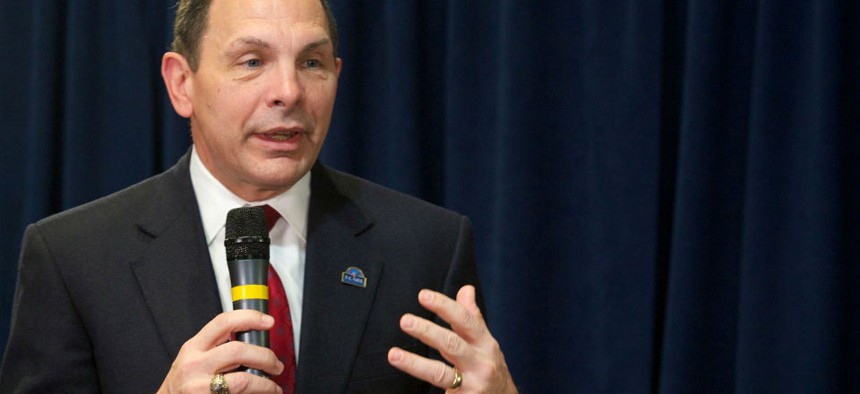Despite Scandal, VA Firings Nosedived in 2014
VA secretary’s numbers on firings related to data manipulation don't match report to Congress.
Despite being entangled in a scandal involving malfeasant employees for much of the year, the Veterans Affairs Department fired about half the number of workers in 2014 than it did the previous year, according to agency and other federal data.
VA terminated about 1,100 employees last calendar year, the agency told Government Executive, down from 2,247 in fiscal 2013. The fiscal 2013 data come from the Office of Personnel Management and measure total firings from Oct. 1, 2012, through Sept. 30, 2013. The calendar year 2014 number was provided by VA, which could not offer an explanation for the drop off.
After being given several days to comment, a VA spokesman said the agency was “reconciling the various numbers.”
President Obama and VA leaders have promised increased accountability -- including the removal of employees engaged in misconduct -- since reports surfaced that agency workers were manipulating patient data to falsify the amount of time veterans had to wait to receive care.
The scandal led to the resignation of then-Secretary Eric Shinseki and a major legislative overhaul of the agency, which included a provision to ease the firing of VA’s senior executives. VA has used the new authority to dismiss five Senior Executive Service employees since Obama signed the bill into law, but two of those individuals retired before the termination took effect.
The firing rate has picked up since new VA Secretary Bob McDonald was sworn in on July 30. In the six months since he took office, VA has fired about 900 employees -- almost entirely for reasons not associated with patient data manipulation. In fact, since June, VA has fired just 11 employees in connection to the scandal -- including the three previously mentioned SESers -- according to a report the agency must provide to Congress and obtained by Government Executive. Ten additional proposed terminations are pending, according to the document dated Feb. 12.
These figures directly contradict comments by McDonald on Sunday’s Meet the Press, during which he said, “We’ve got 60 people that we fired who have manipulated wait times.” When asked about the discrepancy, VA noted the number of total proposals for discipline exceeds 60, but did not comment on McDonald’s quote directly.
VA has also faced difficulty following through on proposed disciplinary actions for individuals involved with cooking the books on waitlist numbers. For more than 20 individuals, proposed terminations have become suspensions or retirements, suspensions have become “reprimands” or “admonishments,” and in some cases punishments have been dropped all together.
Nurses were targeted most frequently by VA in response to the scandal, followed by support staff and a few physicians. The SES employees were at the director level.
In total, VA told Congress it has taken negative personnel actions on 75 employees in connection to the data fudging. Its latest report, however, shows 30 of those proposed actions are either still pending or have since been rescinded. Several more retired or resigned before the action could take effect. Overall, fewer than half of the proposed actions were carried out as originally planned.
Still, a VA spokesman said McDonald is changing the “culture” of the agency, not “just here in Washington, but across all of VA.”
“VA is committed to continued improvements and monitoring of [patient data manipulation] and other issues to improve the VA care, benefits and experience for veterans,” said Randy Noller, the spokesman.
He also said VA will continue to root out employees associated with the scandal, noting: “If additional employees are found to have acted improperly, appropriate action will be taken.”
Some lawmakers have criticized VA’s response since public outrage embroiled the agency, saying VA has acted too slowly to eliminate weak links or by allowing those accused of misconduct to retire. VA has repeatedly said the process takes time, as it must follow burdensome federal regulations before it can remove an employee.
“Nearly all of VA’s most serious and systemic problems stem from a widespread lack of accountability across the department that went unchecked for years,” Rep. Jeff Miller, R-Fla., chairman of the House Veterans' Affairs committee, told Government Executive. “It would be naïve to think these issues would simply vanish upon the appointment of a new secretary and in the absence of the thorough housecleaning the department so desperately needs.”
Miller added VA leadership is saying the right things about accountability, but “instilling a climate of accountability at VA will only be achieved through actions, not words.”
Noller did not comment on why overall terminations declined so dramatically from fiscal 2013 to the 2014 calendar year. Data from the Office of Personnel Management show terminations for discipline or performance have hovered around 2,000 in fiscal years 2011 through 2013, while the figure topped 2,400 in fiscal years 2009 and 2010.
“The fact that VA firings have actually decreased amid the biggest scandal in the department’s history is a troubling development VA leaders must explain and remedy,” Miller said.




